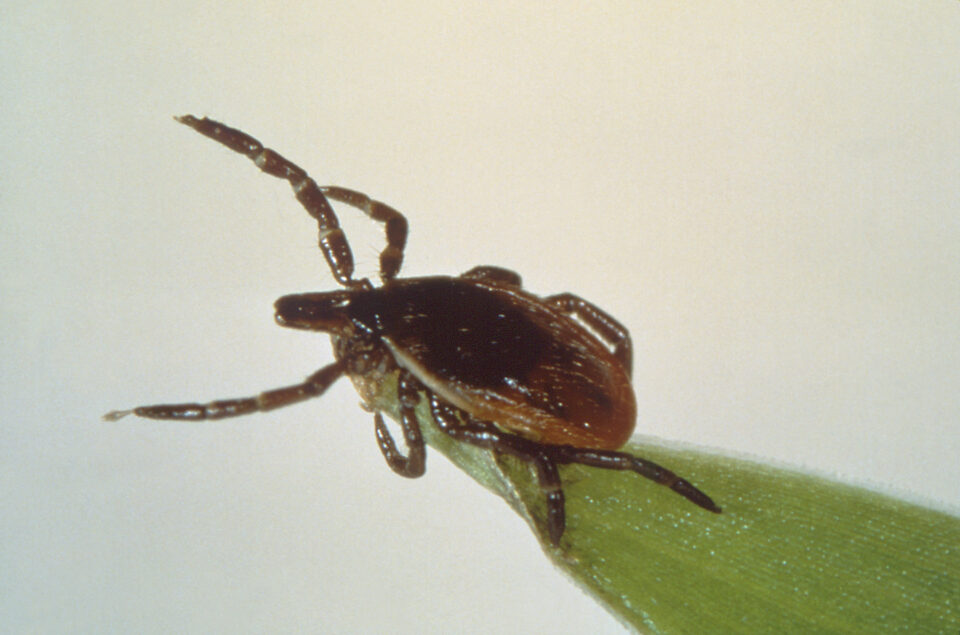Ticks

Ticks feed on the blood of animals (such as rodents, rabbits, deer, and birds), but will bite humans too. When they do, they can sometimes transmit serious and potentially fatal diseases like Lyme disease, ehrlichiosis and tularemia.
The best prevention against tick-borne diseases is to avoid them by staying out of wooded areas with tall grasses or bushes and using insect repellent on clothing and exposed skin. Check yourself and pets for ticks after spending time outdoors.
Tick Diseases
Many of the diseases transmitted by ticks can be treated effectively when caught early, so see a doctor right away if you have a fever, rash or flu-like symptoms after being in tick-infested areas.
Tell your doctor about recent tick bites, when it occurred and where you likely acquired the tick. Frequent tick checks increase the likelihood of finding a tick before it can transmit disease.
Tick: Black-legged tick (Ixodes scapularis); smallest tick in Indiana; appears September to November
Agent: parasite Babesia microti
Incubation: 1 week to months after bite
Initial Symptoms: Fever, chills, sweats, headache, body aches, loss of appetite, nausea or fatigue
Other Symptoms: Jaundice, dark urine
Tick: Lone Star tick (Amblyomma americanum); white-tailed deer are a major host
Agent: Ehrlichia chaffeensis
Incubation: 5-10 days after bite
Initial Symptoms Fever, headache, malaise, and muscle aches
Other Symptoms: Nausea, vomiting, diarrhea, cough, joint pains, confusion and occasionally rash
Tick: Black-legged tick (Ixodes scapularis); smallest tick in Indiana; appears September to November
Agent: Borrelia burgdorferi
Incubation: 3-30 days after bite
Initial Symptoms: Bulls-eye rash, tiredness, fever, headache, stiff neck, muscle aches and joint pain
Later Symptoms: Arthritis, large joint swelling and pain, neurologic abnormalities and encephalitis
Tick: American dog tick (Dermacentor variablis); Largest tick in Indiana; Most prevalent in Allen County; Appears from April to July; Lone Star tick (Amblyomma americanum) can also carry and transmit RMSF
Agent: Rickettsia ricketsii
Incubation: 5-10 days after bite
Initial Symptoms: Fever, nausea, vomiting, severe headache, muscle pain and lack of appetite
Later Symptoms: Rash, abdominal pain, joint pain and diarrhea
Ticks: American dog tick (Dermacentor variabilis), the wood tick (Dermacentor andersoni), and the lone star tick (Amblyomma americanum)
Agent: Bacterium, Francisella tularensis
Incubation: 3 to 5 days after bite but can take as long as 14 days
Symptoms: Signs and symptoms of tularemia vary depending on how the bacteria enters the body. Most common form of tularemia occurs following a tick or deer fly bite or after handing of an infected animal. A skin ulcer appears at the site where the organism entered the body. The ulcer is accompanied by swelling of regional lymph glands, usually in the armpit or groin.
Identifying Ticks
The Department of Health is not able to test ticks for disease. We can identify the tick and provide information on what diseases it could carry. If symptoms appear, a physician can be informed what kind of tick it was and disease the tick could carry. Then appropriate treatment can occur.
CDC has also developed a reference manual to help health care providers to access concise, comprehensive, and updated information about the prevention, identification, and treatment of tickborne diseases. This manual is titled, “Tickborne Diseases of the United States: A Reference Manual for Health Care Providers”.
Please call our Environmental Services Division – Vector Control & Healthy Homes Program at 260.449.7549 for more information or help with identifying ticks.
Removing Ticks
It’s a good idea to bathe or shower as soon as possible after coming indoors (preferably within two hours) to wash off and more easily find ticks that are crawling on you. Then conduct a full-body tick check using a hand-held or full-length mirror to view all parts of your body.
If you find a tick, remove it right away by doing the following:
- Use tweezers. Grasp the tick by the head as close as possible to the skin and pull upward with steady, even pressure. Do not twist, jerk or squeeze the tick. Never use fingernail polish, alcohol or hot matches to remove a tick.
- Thoroughly clean and and disinfect the bite area with soap and water, rubbing alcohol, or an iodine scrub. Be sure to wash your hands as well.
- Dispose of a live tick by submersing it in alcohol, placing it in a sealed bag/container, wrapping it tightly in tape, or flushing it down the toilet. Never crush a tick with your fingers.